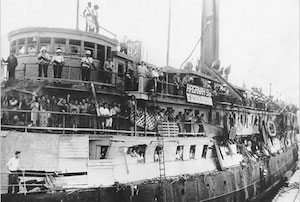Passover Meanings: The Mizrahi Exodus
By Eric Gartman
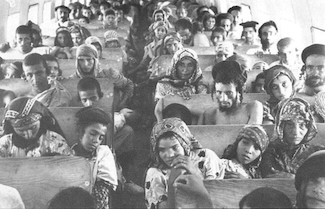
Yemenite Jews en route from Aden to Israel, during the Operation Magic Carpet (1949–1950)
Passover tells the story of the Exodus from Egypt, when the ancient Israelites returned to the Promised Land. More recently, another exodus took place: the return of Jews from Arab lands to Israel. These people were known as Mizrahi Jews, meaning “eastern” Jews, as they hailed from lands east of Europe.
In the years after the creation of the State of Israel in 1949, the situation of these Jews living in Arab lands became untenable. Arab wrath at these Jews grew in the wake of growing Arab nationalism, anger towards Israel, and declining economic conditions. Jews from Morocco to Iraq began to make the long, hard trek to the Jewish homeland. Some left for security; others immigrated for economic reasons or ideological reasons. No matter their motive, it was difficult for many of them to reach the Promised Land. Still, their situation was so dire that they risked life and limb to make the journey.
MIGRATION FROM MOROCCO
Israeli reports from this time bear out the horrendous living conditions of the Jews in North Africa:
The situation of the Jews in the Moroccan Atlas Mountains is beyond description. Mere reading or hearing about it cannot convey the reality that such conditions exist in our time. Whoever has not seen a family of eighteen huddled in one room, five meters long, which serves for living quarters, kitchen and workshop, whoever has not visited rooms in which hundreds of children, all half-naked and with eye diseases which will never be treated, are taught together; whoever has not met the “teacher,” whose only method of teaching is the whip; whoever has not smelled the peculiar smell of the entire quarter – would never believe that such wretchedness can exist, and that fellow human beings be allowed to live like this.
A Jewish Agency report from 1949 described the situation of the Jews in Casablanca: "There are 80,000 Jews in this city, 50,000 of which live in the ghetto. The crowding in these quarters is atrocious, and the hygienic conditions frightful. Congenital syphilis is widespread, and so are trachoma and a scalp disease. In one town at the foot of the Atlas Mountains, we found an entire community that was blind. Whoever was still able to see would soon go blind, because of the ubiquitous trachoma. There is no helping them, because there are no doctors and no one treats the disease."
Another report read:
"The situation of the Jews further inland is particularly bad especially in Cyrenaica [Libya], where the Arabs are openly threatening to massacre them when Sheikh el-Senoussi comes to power. In small towns and villages, Jewish girls are often forced to convert to Islam. A typical case happened just two weeks ago: a local Jewish girl whom an Arab wanted to marry got on one of our ships. When the Arabs in her town discovered this, they demanded that the Jewish community supply them with fifty Jewish virgins within a week. That night more than fifty Jewish families fled that town and came with their daughters to Tripoli."
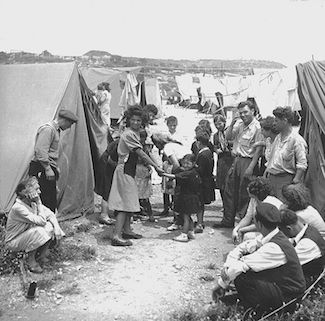
Jewish refugees at Ma'abarot transit camp, 1950
After fleeing their homes in North Africa, the migrants arrived in transit camps set up by the Jewish Agency. Conditions there were appalling. One such camp in Algiers was typical:
"In the Alliance Israelite building and the little alley behind it live masses of people, crowded like animals. From top to bottom, and even on the stairs, you see people sitting with their belongings. They live, cook, fall ill, give birth and die, men and women, young and old, all of them together. More than fifty people live in one room of four or five square meters."
From the transit camps, the migrants were taken to Marseilles on ships, where conditions were severe. The immigrants had virtually no possessions to begin with, nor were they issued any food. There were not enough beds, forcing the migrants to sleep on the floors with no blankets and no warm clothing.
EXODUS FROM YEMEN
As difficult as the journey of the North Africans was, Yemenite Jews had at least as hard a time. They had walked miles on foot across the deserts and mountains of Yemen's interior to reach the port of Aden. Along the way they had been attacked and robbed by bandits, while starvation and thirst made the journey even more dangerous. At Aden, they had gathered into primitive camps, where Arab nationalists had threatened them with knives raised. Finally, they boarded the planes to take them to the Holy Land. They had never seen planes before. Some had preferred to sit in the aisles as the seats were too soft for them. Others had lit portable stoves in midair to cook their meager rations, much to the horror of the flight crews. But they had finally arrived in as part of "Operation Magic Carpet," fulfilling the biblical prophecy of their return on "eagles' wings."
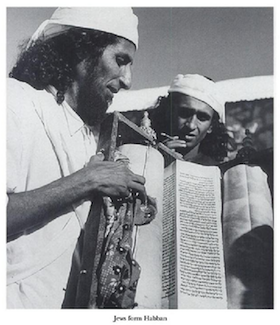
Habban Jews of Yemen
The Yemenite Jews were a colorful people. The men were dressed in white robes with caps and side curls, the women in colorful flowing dresses and hand carved necklaces and earrings. After centuries of suffering in the remote wastes of Yemen, they were returning home. They had never seen planes before, and now they were arriving in them en masse.
Their hardships were far from over, however. Bringing in vast numbers of immigrants strained the small state well beyond its limited capabilities. At first, the new arrivals were housed in empty Arab homes, expropriated by legislation from their absentee owners. The number of Jews who took over such domiciles was considerable, perhaps a quarter of Israel’s Jews. Still, it was not enough. Israel was forced to cram hundreds of thousands of immigrants into transit camps, known as ma' abarot - מעברות.
They had no privacy whatsoever, and living conditions were squalid. At first the immigrants lived in tents, later in canvas huts, and then in wooden huts. There were only a few water taps in the camps, and the whole population had to share them. The poor quality water had to be boiled before it was fit for human use. The schools lacked basic features such as desks, chairs, blackboards chalk, and textbooks. The health clinics were perpetually understaffed and lacked medicine. The camp residents suffered from intense heat and dust in the summer, and wallowed in the mud and cold during the winter. At one point, there was no grain left and no money to pay for another shipment.
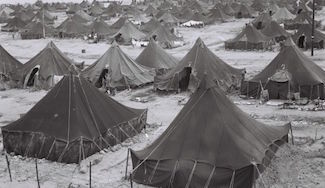
Beit Lid Ma'abaraZoltan Kluger / GPO
Perhaps the worst feature of the camps was the sanitation. One resident wrote:
Nobody washes. In some camps there are hot showers, but in others there is no installation for hot water at all, so that all through the winter it is impossible to bathe, even if they want to. There are entire camps with thousands of men, women, and children, where there is not a single shower room, not even for cold water. And when there is a wretched little bathroom, it is occupied by inmates who have nowhere else to stay...In many camps, therefore, the toilets are nothing more than holes in the ground, lined with sheets of tin, without any sewage or running water. These holes soon fill up and stink up the atmosphere.
Israel's economists—Levi Eshkol, in particular—advised against the massive migrations. He called large-scale immigration suicide, and warned that the people in the camps would starve due to a lack of money. But Ben-Gurion would not consider scaling back the ingathering. “We have no alternative,” he stated. “It is vital to our existence. We must do our best to foster immigration, for the ingathering of the exiles is both our raison d’etre and a prerequisite for our existence.”
Israel had to bring in all the Jews they could in a short a time as possible in spite of the financial and practical challenges imposed on the Jewish state. The Jews in many Arab nations faced imminent crises that threatened their very lives. Moreover, Israel itself faced another war and needed to build up its own strength before the next round.
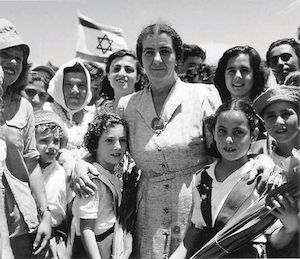
Golda Meir with children of Kibbutz Shefayim - 1950.
Faced with another crisis, Ben-Gurion turned to one of his most trusted advisors: Labor Minister Golda Meir. He sent Meir to the United States on a fund-raising trip. The American-reared minister had collected $50,000,000 from American Jewish donors prior to the War of Independence, money that proved decisive in allowing Israel to acquire much-needed arms. She had saved the country once; now she was being asked to do so again. Meir told her American audience:
I went to our Parliament two weeks ago last Tuesday, and presented a project for 30,000 housing units by the end of this year. Parliament approved it, and there was great joy in the country. But actually I did a strange thing: I presented a project for which I didn't have the money.
What we want to do is give each family a luxurious apartment of one room; one room which we will build out of concrete blocks. We won't even plaster the walls. We will make roofs, but no ceilings. What we hope is that since these people will be learning a trade as they build their houses, they will finish them, and eventually, one day, add on another room. In the meantime, we will be happy, and they will be happy, even though it means putting a family of two, three, four, or five into one room. But this is better than putting two or three families in a single tent…
It is an awful thing to do—to forge a signature to a check, but I have done it. I have promised the people at home and the people in the camps that the government is going to put up these 30,000 units, and we have already started to do so with the little money we have. But there isn't enough for these 30,000 units. It is up to you either to keep these people in camps and send them food packages, or to put them to work and restore their dignity and self-respect.
America's Jews contributed generously; but it was still not enough. Immediate action needed to be taken. There was only one institution capable of organizing a massive building effort: Ben-Gurion turned to IDF chief of staff Yigael Yadin. Yadin vigorously threw himself into organizing a rescue mission headed by the army. The results were impressive. In a mere four months, the army built more permanent housing and schools. They installed water and sanitation and provided medical care to the one hundred or so camps in the country.
It wasn’t easy, but eventually all the immigrants were settled in permanent houses.
Since those difficult days in the early 1950’s, the Mizrahi Jews have become an integral part of the fabric of State of Israel. Their cultural heritage and influence give Israel a diversity it previously lacked when nearly all the immigrants were Ashkenazic Jews from Europe. Most of all, they have both taken sanctuary in the Jewish state, and helped provide sanctuary for other endangered Jews, as their contributions helped built up the state in its early days. This Passover let us remember their Exodus.
Recommended:
YOUR ISRAEL CONNECTION FOR PASSOVER
Bring Israel into your Passover Seder today!
About the Author



